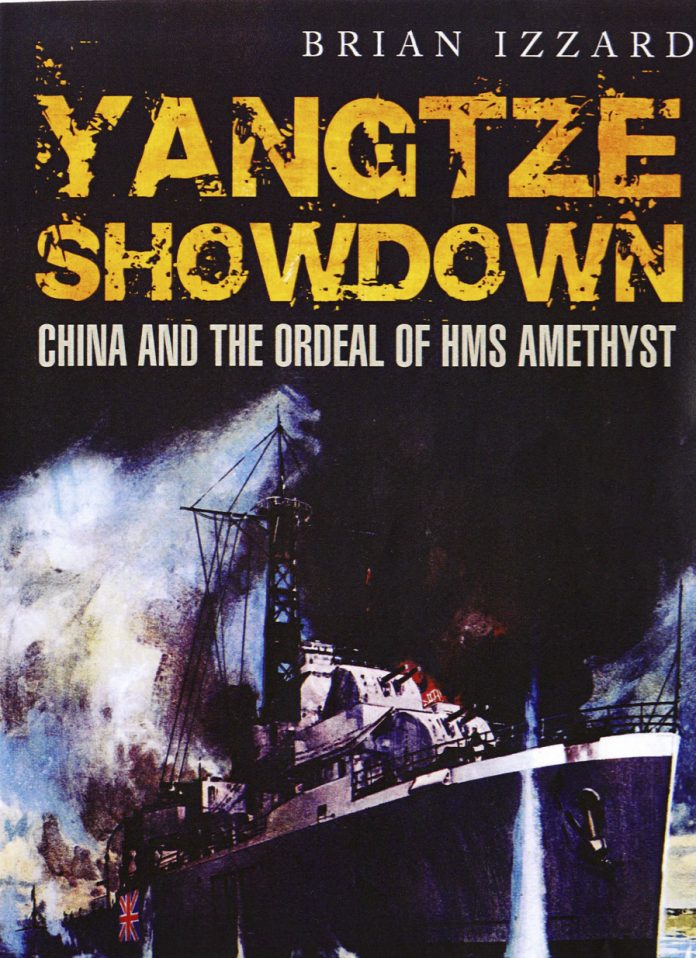
Yangtze Showdown: China and the Ordeal of HMS Amethyst. By Brian Izzard. Seaforth Publishing, Barnsley, 2015.
Reviewed by Mike Fogarty
I THOUGHT all had been written about this famous incident but the author has proved me wrong. Brian Izzard was a Fleet Street journalist and his treatment of the topic is soon apparent. He has written two previous books so he has his eye in for popular history.
Izzard makes some extravagant claims which, while entertaining, have to recede into the mists of time. Tabloid approaches are meant to entertain, for what good is any story without a conspiracy theory or more within? Despite that, it is a readable and enjoyable book and I doubt if too many former naval types will object to his coverage. For he gets it right, as he explains what a fighting ship and navy culture is all about. This includes the obvious, which might be restated, including: leadership, morale, training, tactics and every facet which keeps a man of war at sea to combat an enemy.
The sub-theme is more troubling. Here a gallant ship enters the realms of politics and diplomacy. Current history rarely comes with any guide and the ‘man on the spot’ is charged to produce a satisfactory outcome, one which meets the expectations of his superiors, far away, in the safety of the Admiralty and Parliament itself.
Caught in a civil war, in which the communist victory was all but assured, the Royal Navy could no longer presume innocent right of passage on the Yangtze to provision the British Embassy at Nanking. The communists and the nationalists had their eyes on the prize, to hold and determine the future of a long-contested nation. In the midst of war and revolution, international law was silent.
In 1949, in the middle of the Chinese civil war following WWII, HMS Amethyst was trapped for 101 days after her Captain and key members of his bridge team were killed by communist shelling. His unlikely replacement as commanding officer was Lieutenant Commander John Kerans, RN, who was in Nanking and the only officer who could get down river to Amethyst. He quickly took command and displayed the aggressive qualities and resoluteness expected of any officer of his wartime generation. For some he was a flawed hero, having proved too bold for his own good in social situations in the Mediterranean Fleet. Kerans was decorated with a DSO for his fighting escape from China into the welcoming embrace of Far East Fleet ships assembled in Hong Kong in July. His famous signal announcing his success went around the world: ‘HMS Amethyst has rejoined the Fleet. God save the King’.
The Admiralty was less than grateful in its treatment of Kerans as he was eased out of the service long before his time. He could have been carried in a less demanding post for he saved his country from enduring humiliation. Britain gained, and did not cede pride and prestige, due to the courage of John Kerans.
A brief book review does not allow for a comprehensive survey of this masterly work. It is a book that should be read and not left to any minor survey by another. This account is gripped with tension and it is hard to put down as you want these people to win through, as they surely did. It was a finely run thing and their escape down the river is the feat of legends which will forever be celebrated throughout the endless history of the Royal Navy. Many officers and men were killed or were grievously maimed in the ongoing life of the incident. We should not forget Amethyst did not suffer alone, and recall that personnel aboard HM ships Consort, London and Black Swan also suffered fatalities with many wounded. HMS Concord also had a key role and the author suggests that an official decision not to award its crew the Naval General Service Medal with clasp “Yangtze, 1949” was an inadequate response to a warship which was equally prepared to enter harm’s way.
Before reading the book, have a quick look at the appendices. They note the ships which took part, listing those killed and wounded, decorations awarded, including a useful timeline of main events which one can put into acute perspective. The book evidences voluminous sources and a comprehensive bibliography.
What relevance is this book to any Australian readership, service or otherwise? It is instructive that HMAS Shoalhaven was initially tasked to take up guard ship duties to support Commonwealth diplomatic missions at the time. The Australian envoy, Sir Keith Officer, prudently averred from exposing an Australian warship to clear and present danger, as his prescience was later publicly affirmed by the unfolding events which were looming as a potential disaster but for good luck and the courageous leadership which remains inspirational to this day.
If anything, it also attests that any commanding officer has to bring a suite of skills to the obligations of command. In the absence of a professional diplomat by his or her side, on the bridge or elsewhere, a commander must know and exercise the political and diplomatic instincts in times of peril in an independent command.
But in the end, Kerans was the man of the moment, he had to make it so, as he would rise or fall with his ship and all those under his leadership. Diplomats are spared to safely negotiate political settlements. Invariably, commanders are left to pursue the combat on their battlefields. Some of our Foreign Affairs colleagues might envy John Kerans, with his communications down, he backed his instincts, and freed from official policy molestation, he showed his mettle when courage and leadership were demanded of him.
(This review is based upon that published by the Australian Institute of International Affairs)



